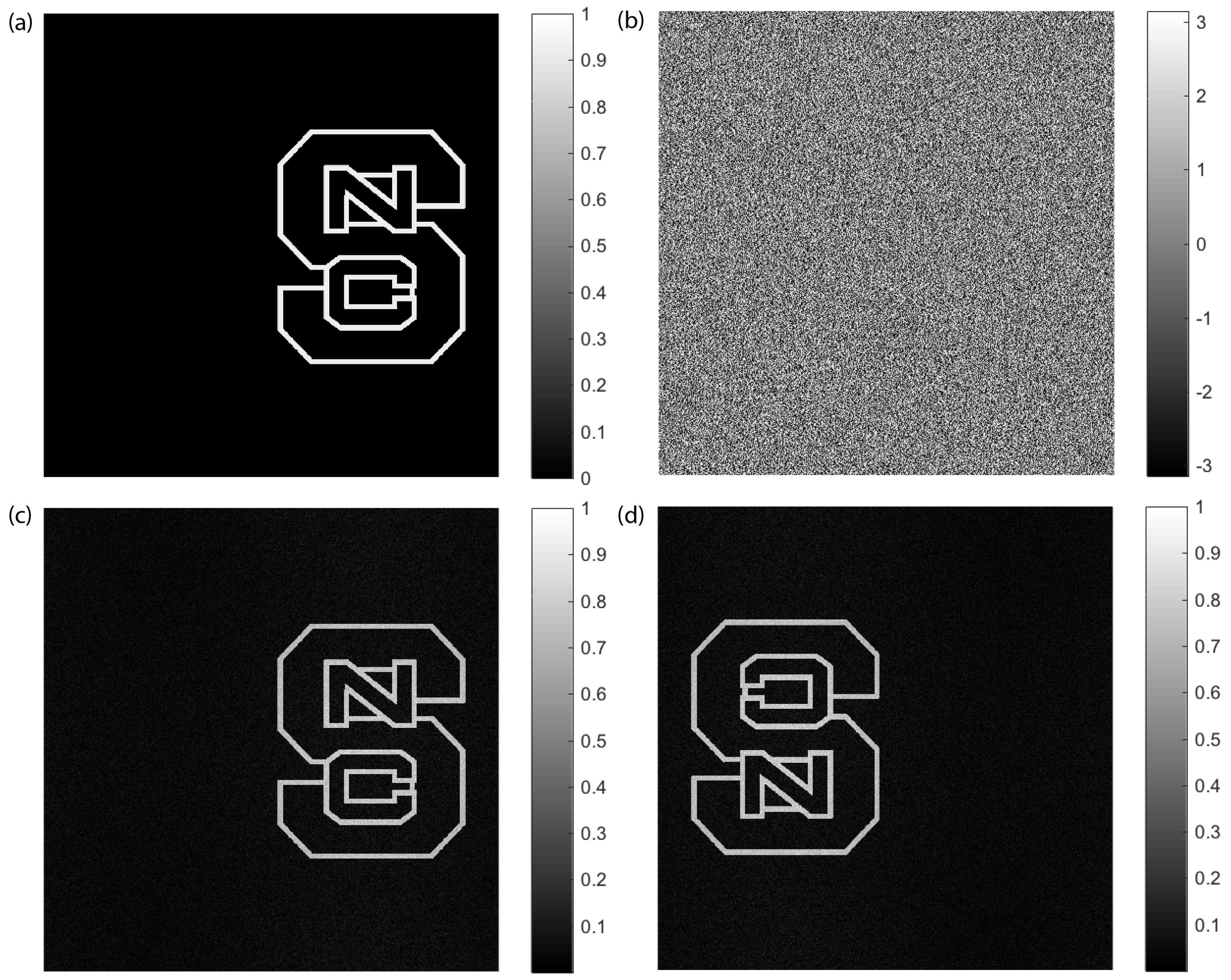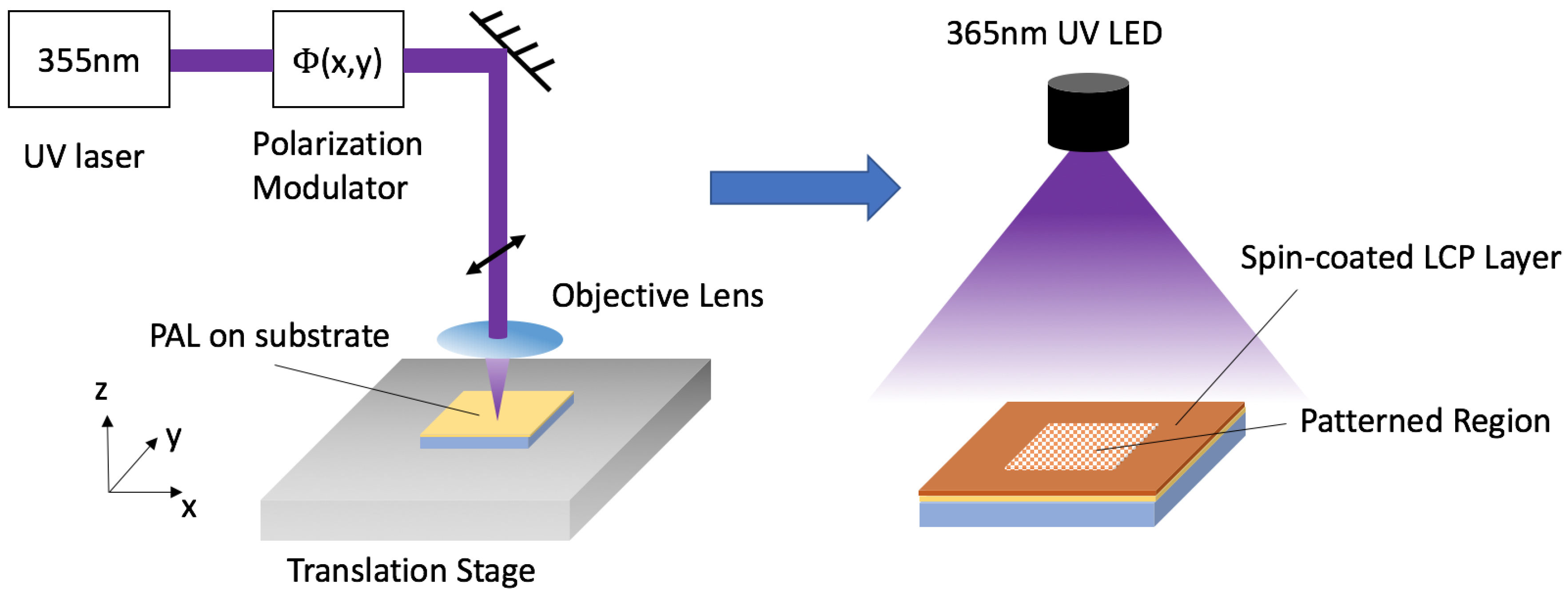Far-field and Fresnel Liquid Crystal Geometric Phase Holograms via Direct-Write Photo-Alignment
Abstract
:1. Introduction
2. Background
3. Results
3.1. Simulation Results
3.2. Experimental Results
3.2.1. Far-Field Geometric Phase Hologram
3.2.2. Fresnel Geometric Phase Hologram
4. Discussion
5. Materials and Methods
6. Conclusions
Acknowledgments
Author Contributions
Conflicts of Interest
References
- Kim, J.; Li, Y.; Miskiewicz, M.N.; Oh, C.; Kudenov, M.W.; Escuti, M.J. Fabrication of ideal geometric-phase holograms with arbitrary wavefronts. Optica 2015, 11, 958–964. [Google Scholar] [CrossRef]
- De Sio, L.; Roberts, D.E.; Liao, Z.; Nersisyan, S.; Uskova, O.; Wickboldt, L.; Tabiryan, N.; Steeves, D.M.; Kimball, B.R. Digital polarization holography advancing geometrical phase optics. Opt. Express 2016, 24, 18297–18306. [Google Scholar] [CrossRef] [PubMed]
- Hasman, E.; Kleiner, V.; Biener, G.; Niv, A. Polarization dependent focusing lens by use of quantized Pancharatnam-Berry phase diffractive optics. Appl. Phys. Lett. 2003, 82, 328–330. [Google Scholar] [CrossRef]
- Xiang, X.; Kim, J.; Escuti, M.J. Nanoscale liquid crystal polymer Braggpolarization gratings. Opt. Express 2017, 25, 19298–19308. [Google Scholar] [CrossRef] [PubMed]
- Li, Y.; Kim, J.; Escuti, M.J. Orbital angular momentum generation and mode transformation with high efficiency using forked polarization gratings. Appl. Opt. 2012, 51, 8236–8245. [Google Scholar] [CrossRef] [PubMed]
- Marrucci, L.; Manzo, C.; Paparo, D. Pancharatnam-Berry phase optical elements for wavefront shaping in the visible domain: Switchable helical modes generation. Appl. Phys. Lett. 2006, 88, 221102. [Google Scholar] [CrossRef]
- Fratz, M.; Sinzinger, S.; Giel, D. Design and fabrication of polarization-holographic elements for laser beam shaping. Appl. Opt. 2009, 48, 2669–2677. [Google Scholar] [CrossRef] [PubMed]
- Snik, F.; Otten, G.; Kenworthy, M.; Miskiewicz, M.; Escuti, M.; Packham, C.; Codona, J. The vector-app: A broadband apodizing phase plate that yields complementary PSFs. Proc. SPIE 2012, 8450. [Google Scholar] [CrossRef]
- Modes, C.D.; Warner, M.; Sanchez-Somolinos, C.; de Haan, L.T.; Broer, D. Mechanical frustration and spontaneous polygonal folding in active nematic sheets. Phys. Rev. E 2012, 85, 060701. [Google Scholar] [CrossRef] [PubMed]
- Pancharatnam, S. Achromatic combinations of birefringent plates. Part 1: An Achromatic Circular Polarizer. Proc. Indian Acad. Sci. A 1955, 41, 130–136. [Google Scholar]
- Anandan, J. The geometric phase. Nature 1992, 360, 307–313. [Google Scholar] [CrossRef]
- Aerle, N.A.J.M.; Barmentlo, M.; Hollering, R.W.J. Effect of rubbing on the molecular orientation within polyimide orienting layers of liquid crystal displays. J. Appl. Phys. 1993, 74, 3111–3120. [Google Scholar] [CrossRef]
- Chigrinov, V.G.; Kozenkov, V.M.; Kwok, H.S. Photoalignment of Liquid Crystalline Materials; JohnWiley & Sons: Chichester, UK, 2008. [Google Scholar]
- Yaroshchuk, O.; Reznikov, Y. Photoalignment of liquid crystals: Basics and current trends. J. Mater. Chem. 2012, 22, 286–300. [Google Scholar] [CrossRef]
- Chigrinov, V.; Muravski, A.; Kwok, H.-S.; Takada, H.; Akiyama, H.; Takatsu, H. Anchoring properties of photoaligned azo-dye materials. Phys. Rev. E 2003, 68, 061702. [Google Scholar] [CrossRef] [PubMed]
- Shteyner, E.A.; Srivastava, A.K.; Chigrinov, V.G.; Kwok, H.-S.; Afanasyev, A.D. Submicron-scale liquid crystal photo-alignment. Soft Matter 2013, 9, 5160–5165. [Google Scholar] [CrossRef]
- Todorov, T.; Nikolova, L.; Stoyanova, K.; Tomova, N. Polarization holography. 3: Some applications of polarization holographic recording. Appl. Opt. 1985, 24, 785–788. [Google Scholar] [CrossRef] [PubMed]
- Crawford, G.; Eakin, J.; Radcliffe, M.; Callan-Jones, A.; Pelcovits, R. Liquid-crystal diffraction gratings using polarization holography alignment techniques. J. Appl. Phys. 2005, 27, 123102. [Google Scholar] [CrossRef]
- Culbreath, C.; Glazar, N.; Yokoyama, H. Note: Automated maskless micro-multidomain photoalignment. Rev. Sci. Instrum. 2011, 82, 126107. [Google Scholar] [CrossRef] [PubMed]
- Wu, H.; Hu, W.; Hu, H.; Lin, X.; Zhu, G.; Choi, J.-W.; Chigrinov, V.; Lu, Y. Arbitrary photo-patterning in liquid crystal alignments using DMD based lithography system. Opt. Express 2012, 20, 16684–16689. [Google Scholar] [CrossRef]
- Guo, Y.; Jiang, M.; Peng, C.; Sun, K.; Yaroshchuk, O.; Lavrentovich, O.; Wei, Q.-H. High-Resolution and High-Throughput Plasmonic Photopatterning of Complex Molecular Orientations in Liquid Crystals. Adv. Mater. 2016, 28, 2353–2358. [Google Scholar] [CrossRef] [PubMed]
- Miskiewicz, M.N.; Escuti, M.J. Direct-writing of complex liquid crystal patterns. Opt. Express 2014, 39, 1521–1524. [Google Scholar] [CrossRef] [PubMed]
- Hornburg, K.J.; Kim, J.; Escuti, M.J. Experimental characterization of a F/1.5 geometric-phase lens with high achromatic efficiency and low aberration. Proc. SPIE 2017, 10125. [Google Scholar] [CrossRef]
- Xiang, X.; Miskiewicz, M.N.; Escuti, M.J. Distortion-free broadband holograms: A novel class of elements utilizing the wavelength-independent geometric phase. Proc. SPIE 2015, 9386, 938609. [Google Scholar]
- Wyrowski, F.; Hauck, R.; Bryngdahl, O. Computer-generated holography: Hologram repetition and phase manipulations. J. Opt. Soc. Am. A 1987, 4, 694–698. [Google Scholar] [CrossRef]
- Yaras, F.; Kang, H.; Onural, L. Real-time phase-only color holographic video display system using LED illumination. Appl. Opt. 2005, 48, H48–H53. [Google Scholar] [CrossRef] [PubMed]
- Fienup, J.R. Phase retrieval algorithms: A comparison. Appl. Opt. 1982, 21, 2758–2769. [Google Scholar] [CrossRef] [PubMed]
- Jackin, B.J.; Narayanamurthy, C.S.; Yatagai, T. Geometric phase shifting digital holography. Opt. Lett. 2016, 41, 2648–2651. [Google Scholar] [CrossRef] [PubMed]
- Zheng, G.; Muhlenbernd, H.; Kenney, M.; Li, G.; Zentgraf, T.; Zhang, S. Metasurface holograms reaching 80% efficiency. Nat. Nanotechnol. 2015, 10, 308–312. [Google Scholar] [CrossRef] [PubMed]
- Choudhury, S.; Guler, U.; Shaltout, A.; Shalaev, V.M.; Kildishev, A.V.; Boltasseva, A. Pancharatnam-Berry Phase Manipulating Metasurface for Visible Color Hologram Based on Low Loss Silver Thin Film. Adv. Opt. Mater. 2017, 5, 1700196. [Google Scholar] [CrossRef]
- Fienup, J.R. Iterative method applied to image reconstruction and to computer-generated holograms. Appl. Opt. 1980, 19, 297–305. [Google Scholar] [CrossRef]
- Oh, C.; Escuti, M.J. Achromatic diffraction from polarization gratings with high efficiency. Opt. Lett. 2008, 33, 2287–2289. [Google Scholar] [CrossRef] [PubMed]






© 2017 by the authors. Licensee MDPI, Basel, Switzerland. This article is an open access article distributed under the terms and conditions of the Creative Commons Attribution (CC BY) license (http://creativecommons.org/licenses/by/4.0/).
Share and Cite
Xiang, X.; Kim, J.; Escuti, M.J. Far-field and Fresnel Liquid Crystal Geometric Phase Holograms via Direct-Write Photo-Alignment. Crystals 2017, 7, 383. https://doi.org/10.3390/cryst7120383
Xiang X, Kim J, Escuti MJ. Far-field and Fresnel Liquid Crystal Geometric Phase Holograms via Direct-Write Photo-Alignment. Crystals. 2017; 7(12):383. https://doi.org/10.3390/cryst7120383
Chicago/Turabian StyleXiang, Xiao, Jihwan Kim, and Michael J. Escuti. 2017. "Far-field and Fresnel Liquid Crystal Geometric Phase Holograms via Direct-Write Photo-Alignment" Crystals 7, no. 12: 383. https://doi.org/10.3390/cryst7120383




